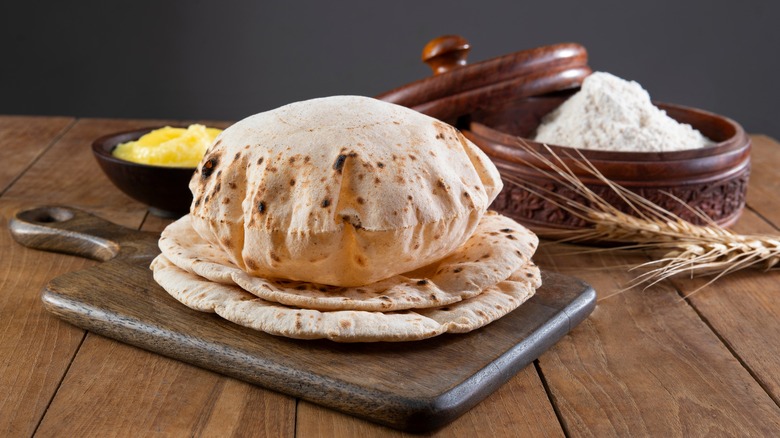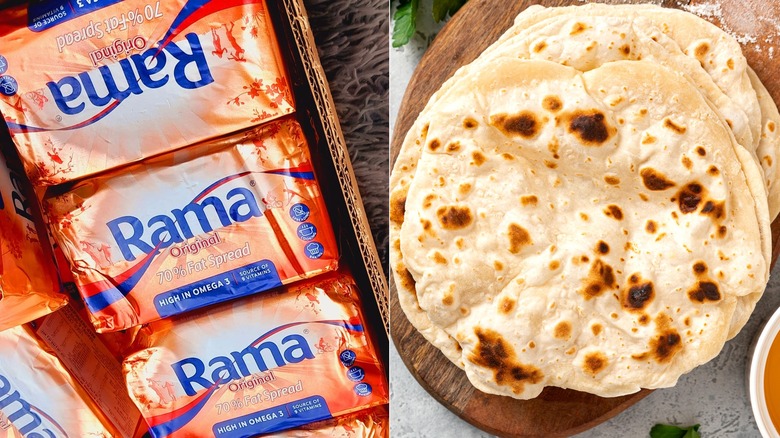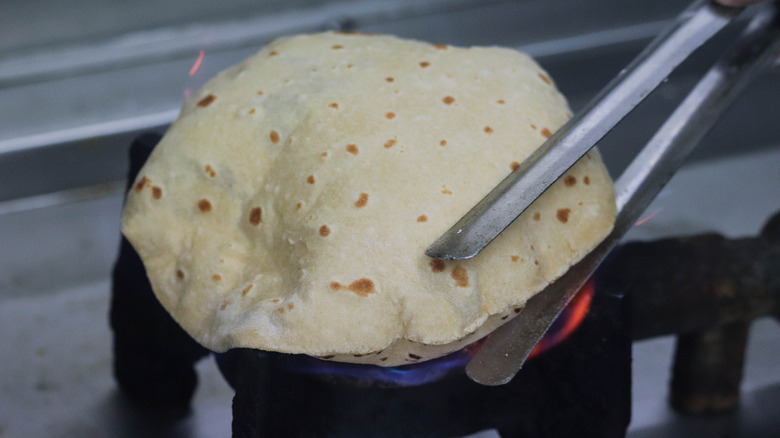The Butter Substitute To Use For Impossibly Soft Roti Bread
Whether you're scooping up tantalizing Indian dishes or simply using it as a wrap for a quick snack, roti is the versatile South Asian bread that can do it all. The round, unleavened, tortilla-like roti is made from "atta" — finely ground whole wheat flour for flatbreads.
Though traditionally rolled out on a board with a wooden rolling pin, you can just as easily stamp out rotis on any flat surface using a wine bottle. Rolling out perfectly round rotis requires some practice, but the real test is its softness — the secret lies in the dough, which must be soft and have a smooth texture. In addition to proper kneading and resting, adding a bit of margarine or vegetable oil to the dough ensures that your rotis turn out deliciously soft and stay that way. A multipurpose margarine like Rama is well suited for rotis, and you can even get the salted kind for added flavor. The fat protects your dough from drying out and also limits the amount of dry flour used, too much of which can harden rotis.
Names of Indian dishes vary across regions, so whether you're making the slightly thicker roti that's more common in North India, the thin and delicate "rotli," or a light and airy puffed-up "phulka," remember that they all start with the same dough, and adding a bit of fat to it can help make this quick and easy flatbread turn out wonderfully soft.
Margarine helps keep roti dough moist
A small amount of margarine or oil will give your dough an appropriately smooth and pliable consistency, and about 1 to 2 tablespoons of oil per 2 cups of flour will yield about ten rotis. You can even add a combination of Rama and vegetable oil to get the softest results. Adding fat to the flour does several things for your dough. First, it makes it less sticky and easier to work with; more moisture means more softness, and without the added fat, the dough will require more flour, which can create toughness. (This is also why you must shake off excess dry flour before transferring the disks to the pan.) You can also smear oil on the surface of the dough before covering it with a cloth to rest.
@cookingwithchanel_sa Once you have been making roti for a while, you wont even need a measuring cup😃 #indianfood #indianrecipes #howtotiktok #softroti #easyrecipe #breadrecipe #TiktokThatsHau
One of the main pitfalls to watch out for when making rotis is overcooking, which will dry them out. Thankfully the margarine helps heat travel faster through the dough, speeding up the process and conserving moisture. Margarine, vegetable oil, ghee, and even olive oil can be used in roti dough (and spread over the finished product), and each one will impart a light flavor to the soft and airy flatbread.
The soft roti checklist
While adding Rama to the dough can be the crowning move in the quest for soft rotis, a few other simple steps can ensure consistently tender outcomes. Using hot water to knead the dough limits gluten formation, which helps keep the roti soft and delicate. Too much gluten can result in an elastic texture, which works for leavened bread (which is why bread flour has more gluten) but has a detrimental effect on flatbreads like rotis or tortillas. However, some gluten formation is necessary for rolling out the round bread, so knead the dough until it is smooth and soft, then allow it to rest for about 20 minutes under a moist cloth. A brief knead just before rolling it out also helps return pliability to the dough.
Conserving moisture is critical for soft rotis, an aspect to pay close attention to during cooking. Pre-heat the pan before placing the roti on it; the more time the dough cooks, the more it risks drying out. Cook both sides on medium-high until small char spots appear and no patches of raw dough are left. Often, a roti is finished on an open flame, which causes some of the moisture inside to turn into steam and puff up the flatbread. This results in its distinctive dual layers, but the open flame can also rapidly dry out moisture, so don't char up your roti for more than a few seconds.


